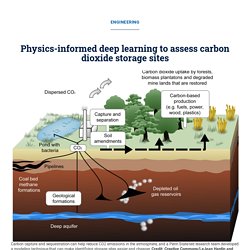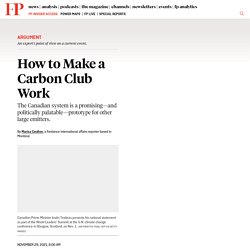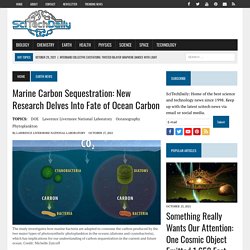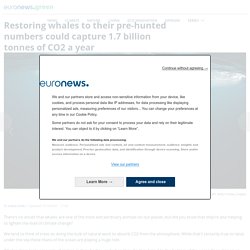

TechCrunch is part of the Yahoo family of brands. TechCrunch is part of the Yahoo family of brands.

By clicking "Accept all" you agree that Yahoo and our partners will store and/or access information on your device through the use of cookies and similar technologies and process your personal data, to display personalised ads and content, for ad and content measurement, audience insights and product development. Your personal data that may be used Information about your account, device and internet connection, including your IP address Browsing and search activity while using Yahoo websites and apps Precise location. What Is Carbon Capture and Storage (CCS)? The Vacuum the Climate May Depend On. The most recent report by the world’s top climate scientists was alarmingly clear: If we are to avoid the most calamitous consequences of warming our planet, we must get as good at taking carbon dioxide out of the atmosphere as we’ve been at putting it in.

Even if solar panels and wind turbines sprout like mushrooms, reaching “net-zero” is going to require capturing large amounts of emissions from activities that are hard to decarbonize, like making cement. Holding temperatures down will also require vacuuming huge amounts of carbon out of the air. The challenge is that current technology for both these tasks is a long, long way from being able to reach these goals. In a projection by the International Energy Agency (IEA) of a pathway to net-zero emissions by 2050, about 7.6 billion metric tons (or gigatons) would still need to be eliminated annually, a figure equal to about a fifth of current emissions. -supported Study Confirms Strength of Southern Ocean Carbon Sink. -supported Study Confirms Strength of Southern Ocean Carbon Sink. Physics-informed deep learning to assess carbon dioxide storage sites. The simulated training data approximate the performance of a system, from which the algorithms identify patterns they can use to make estimations on future behavior — but these patterns do not always obey the laws of physics.

Although driven by data, the models can make inaccurate predictions for a system for many reasons, including inaccuracies in data. Limited training data may lead to estimations that are too specifically tailored to the dataset, a problem known as overfitting. The researchers addressed this shortcoming by incorporating physics to refine the deep learning algorithms’ predictions, developing models constrained by fundamental physics principles, such as the natural movements of subterranean liquids or for the law of conservation of mass. When physics-based discrepancies occurred, the team added a penalty to help the algorithm learn to correct the mistake. “Using a physics-informed approach makes the model more versatile,” she said.
Energy Dome uses CO2 for long-term power storage for solar energy. An error occurred with this part of the page, sorry for the inconvenience.

Longer-term energy storage is a drag, and a lot of battery tech has been focusing on “how quickly can we charge these batteries so I can drive my EV for another couple of hundred miles.”... Dating app giant Match has settled its lawsuit with a group of Tinder founders and executives for $441 million. The suit, filed in 2018, had alleged that IAC and its then-subsidiary Match Group had...
General Motors is deepening its commitment to operate a vertically integrated battery supply chain with the announcement that it would form a joint venture with South Korea-based POSCO Chemical to ... You’d be forgiven if the AirPeak S1 slipped your mind. The final member of an international hacking group known as ‘The Community’ has been sentenced for his role in a multimillion-dollar SIM hijacking campaign, the U.S.
Urtopia, the latest e-bike brand from China, has other ideas. Green ammonia electrolysis breakthrough could finally kill Haber-Bosch. Scientists at Australia's Monash University claim to have made a critical breakthrough in green ammonia production that could displace the extremely dirty Haber-Bosch process, with the potential to eliminate nearly two percent of global greenhouse emissions.

Ammonia is one of the most heavily-produced industrial chemicals in the world, and absolutely vital to modern society. Currently, the majority of ammonia is used as an agricultural fertilizer, but it's also used in plastics, fibers, explosives, pharmaceuticals and other areas. Canada's Carbon Pricing System Is a Model for the World. The United Nations climate change conference in Glasgow, Scotland—known as COP26—closed on Nov. 13 with a new climate agreement: the Glasgow Climate Pact.

The pact reaffirms the global community’s commitment to limiting warming to 1.5 degrees Celsius and includes commitments to reduce methane, end deforestation, and support the countries most impacted by climate change. But like most international agreements, the pact lacks an enforcement mechanism. States are strongly encouraged to reduce emissions, but they can’t be forced to do so, and if they fall short of targets, there will be few repercussions—if any. As a result, some experts are putting their money on economic rather than political solutions to the climate crisis. Cautious hope for CO2 capture after "false starts" The pipeline of carbon capture projects worldwide is growing and there are signs that fewer plans will die on the vine than in the past, the International Energy Agency said.

Why it matters: Carbon capture, utilization and storage has the potential to curb emissions from heavy industries and power generation. But the long-hoped-for scale-up of commercial deployment has unfolded very slowly. Driving the news: The new IEA commentary says over 100 projects have been announced this year. And more projects may survive the journey from concept to commercial operation, writes Samantha McCulloch, head of IEA's CCUS unit. "While CCUS certainly still faces challenges, the combination of strengthened climate goals, an improved investment environment and new business models have set the stage for greater success in coming years," she writes.
New knowledge towards increasing carbon dioxide uptake in plants. Imagine being able to grow plants that could absorb even more CO2 from Earth's atmosphere and thereby help solve the world's climate problems.

Humans have selected, bred and optimized plants to increase food production and ensure for our survival for thousands of years. But the most important and fundamental function of life on Earth—photosynthesis—has not been relevant with regards to plant selection or breeding until now, an age when greenhouse gas emissions from human activities threaten our planet. With new technologies at hand, scientists around the world are now working to understand the internal processes of plants that drive photosynthesis.
In a new study published in the scientific journal PNAS, researchers from the University of Copenhagen's Department of Plant and Environmental Sciences have just discovered that a group of proteins in plant leaf cells, called CURT1, plays a much more important role in photosynthesis than once thought. Proteins that kickstart photosynthesis. Using microbes to make carbon-neutral fuel. A natural CO2-sink thanks to symbiotic bacteria. Marine Carbon Sequestration: New Research Delves Into Fate of Ocean Carbon. The study investigates how marine bacteria are adapted to consume the carbon produced by the two major types of photosynthetic phytoplankton in the oceans (diatoms and cyanobacteria), which has implications for our understanding of carbon sequestration in the current and future ocean.

Credit: Michelle Zatcoff Marine-dissolved organic matter, which originates from phytoplankton, holds as much carbon as Earth’s atmosphere, yet the biological processes governing its fate are primarily studied under idealized laboratory conditions or through indirect measures such as genome sequencing. Restoring whales to their pre-hunted numbers could capture 1.7 billion tonnes of CO2 a year.
There’s no doubt that whales are one of the most extraordinary animals on our planet, but did you know that they’re also helping to lighten the load of climate change?

We tend to think of trees as doing the bulk of natural work to absorb CO2 from the atmosphere. While that’s certainly true on land, under the sea these titans of the ocean are playing a huge role. Whales store large amounts of carbon in their bodies, and when they die they take it to the bottom of the ocean floor. Known as ‘whale falls’, these sinking carcasses ensure that the carbon is trapped in the deep sea rather than being released in surface waters. New photocatalyst produces ammonia from atmospheric nitrogen at room temperature without fossil fuels. Ammonia (NH3) is a major component in fertilizer and a promising carbon-free energy carrier. However, ammonia production consumes around 2 percent of the world's total energy production and releases 500 Mt of carbon dioxide annually. A research team led by scientists at City University of Hong Kong (CityU) developed a new kind of photocatalyst that can produce ammonia from atmospheric nitrogen at room temperature using sunlight.
This new method outperformed the conventional way which causes massive carbon emissions. The research team believed that such technology of sustainable ammonia production would advance the development of the future nitrogen economy. This research was led by Professor Leung Kwok Hi Michael, Shun Hing Education and Charity Fund Professor of Energy and Environment and Assistant Professor Dr. Ammonia: an emerging fuel that could replace petroleum and coal in generating electricity. Liquid metal helps convert CO2 into battery, manufacturing resources. In a paper published in the journal Advanced Materials, the scientists explain that the newly discovered process dissolves captured CO2 gas into a solvent around nanoparticles of gallium, which exist in liquid state above 30°C. The reactor also contains nano-sized solid silver rods that are the key to generating the triboelectrochemical reactions that take place once mechanical energy, for example, stirring or mixing, is introduced.
The reactions break the carbon dioxide into oxygen gas, as well as carbonaceous sheets which ‘float’ to the surface of the container due to differences in density and can therefore be easily extracted. According to the research team, the process showed 92% efficiency in converting a tonne of CO2, using just 230kWh of energy. Researchers develop catalyst for stable reduction of carbon dioxide. Electrocatalytic carbon dioxide reduction (CO2RR) is an effective means of CO2 resource utilization. The current developed catalysts can effectively catalyze CO2RR to prepare a variety of carbon-based fuels such as formic (HCOOH) which is most likely to be commercialized in the future. However, the current catalyst present particle agglomerate, active-phase change and element dissolution during the high-speed electrolysis, resulting in the rapid drop of HCOOH selectivity.
It is necessary to develop catalysts with both activity and stability to realize the industrial preparation of electrocatalytic CO2 to HCOOH. A research team led by Prof. Cyanobacteria engineered to accept external electricity turn carbon dioxide into fuel. Carbon offsets: What are they and do they work? So what is that, exactly? The idea is that any carbon emitting process, from a long-haul flight to electricity generation, can be offset by paying someone else to plant trees, preserve a forest or create renewable energy. In other words: you can take that flight to Hawaii without harming the planet. In principle, it's a great idea, and one that helps people feel less guilty about polluting activities. The market for carbon offsets is expected to reach $200 billion by 2050, according to German bank Berenberg, making it a business with massive potential.
But the industry is still relatively young, and extremely complicated. Enter Kyoto Carbon offsetting has its roots in the landmark 1997 United Nations climate accord, the Kyoto Protocol, where industrialized nations agreed to reduce their carbon emissions. A Complete Visual Guide to Carbon Markets. Mining may be an industry nearly as old as humankind itself, but the process of how a patch of ground becomes a mine is no different from the modern start-up. It takes someone with vision, knowledge, capital, and especially social skills to navigate the hurdles and pitfalls in order to move their project forward and become a true mining entrepreneur.
This infographic sponsored by Cartier Resources takes a look at the journey of a mining entrepreneur, from inspiration to market success. 1. Inspiration: Seeing Value Where Others Do Not This is where all great businesses start…a great idea! An old mine that was closed because of low pricesA geological trend that could continue onto a new propertyA unique geochemical pattern that could hint at more belowAn old property with a new geological insight Real World Example: Uranium in Moose Pasture.
Letting Carbon Sink with the Fishes. Covalent's Carbon-Capturing Sunglasses Offer a View of Fashion's Future. Global carbon capture projects surge 50% in 9 months -research. Researchers are testing a new carbon capture method. Liquid metal proven to be cheap and efficient CO2 converter. Concrete industry says carbon capture a key to hitting emissions targets.
Can we harness the natural power of the ocean to fight climate change? Agriculture has produced just 1% of issued carbon credits. Scientists Synthesized Starch From CO2 in a World First. Keeping the world fed is not an easy task; in fact, it causes immense environmental damage due to the massive use of land, water, fertilizer, pesticides, and fuel. From being used in everything from bread to paper, starch has a secured place in this list, yet we rely on plants to manufacture it, which is rather inefficient. Cyanobacteria engineered to accept external electricity turn carbon dioxide into fuel. Engineered E. coli could make carbohydrates, renewable fuel, from CO2. Researchers are developing a process for converting carbon dioxide into ethanol. Mini carbon-capture plants to slash costs, Mitsubishi Heavy says - Nikkei Asia. Catalyst study advances carbon-dioxide-to-ethanol conversion. Scrubbers Can be Adapted for Low-Level Carbon Capture 'Relatively Quickly': Yara - Ship & Bunker.
World's largest plant capturing carbon from air starts in Iceland. Making methane from CO2: Carbon capture grows more affordable: Methane made from CO2 and renewable hydrogen offers a new path toward cheaper carbon capture. TechCrunch is now a part of Verizon Media. Good news: The most popular material on Earth can store CO2. From jet fuel to clothes, microbes can help us recycle carbon dioxide into everyday products. From jet fuel to clothes, microbes can help us recycle carbon dioxide into everyday products. The Dream of Carbon Air Capture Edges Toward Reality. Capturing Atmospheric Carbon Dioxide and Transforming It Into Industrially Useful Materials. Agora Energy’s Solution Will Turn CO2 & Electricity Into Industrial Feedstocks Cheaply. Agora CO2 Redox Battery Wins Global Deeptech Competitions & Has 1 Year ROI. Effectively removing carbon dioxide from the atmosphere. TechCrunch is now a part of Verizon Media. SeaChange clinches grand prize of S$1 million for solution to sequester carbon dioxide from seawater.
Norway begins "absolutely necessary" project to bury CO2 under North Sea. Carbon Capture: The Key Answer on Climate Change. Climate crisis and carbon capture: Why some are worried about its role. Carbon Capture Pioneers Say Carbon Capture Tech Won’t Save Us. The carbon removal market is expanding. Capturing Carbon with Underwater Gardening. To Combat Climate Change, Researchers Want to Pull Carbon Dioxide From the Ocean and Turn It Into Rock. Growing food with air and solar power: More efficient than planting crops. Underground Sun Conversion tech uses sunlight to produce natural gas. Using visible light to efficiently decompose carbon dioxide.
Open Ocean Particle Flux Variability From Surface to Seafloor - Cael - 2021 - Geophysical Research Letters. Mineral Carbonation International aims to capture "a billion tonnes of CO2" Carbon-capturing concrete company is "taking CO2 out of the system" Carbon Capture Investment Soars As CO2 Levels Hit Record High. To Combat Climate Change, Researchers Want to Pull Carbon Dioxide From the Ocean and Turn It Into Rock.
Green and Economical: Underground Storage of Carbon Captured Directly From Air. Underground storage of carbon captured directly from air—green and economical. Carbon-Capture Tech Mimics The Seashell Forming Process. Passing the acid test: New low-pH system recycles more carbon into valuable products. Algal biodiesel could be the best eco-friendly fuel option of tomorrow. Carbon-capture tech removes CO2 from the ocean by making seashells. Catalytic Hydrogenation of CO2 to Methanol: Low Temperature and High Efficiency. Prometheus Fuels Turns CO2 From Air Into Net-Zero Gasoline. Climate change: six priorities for pulling carbon out of the air. Carbon Capture Technologies Are Improving Nicely. The math isn’t adding up on forests and CO2 reductions. XPRIZE, AirMiners and Creative Destruction Lab Announce Partnership to Support Early-Stage Carbon Removal Startups Interested In $100M XPRIZE Carbon Removal.
The math behind carbon emission reduction targets. Carbon capture eyes renewed backing despite past failures. How the Pacific Northwest is playing a key role in the burgeoning world of carbon capture tech - GeekWire. A Sponge to Soak Up Carbon Dioxide From the Air. Yahoo fait désormais partie de Verizon Media. Carbon dioxide mitigation on Earth and magnesium civilization on Mars. Inside America's Race to Scale Carbon-Capture Technology. Australian scientists achieve breakthrough with renewably powered carbon capture. Startup Raises $9 Million for its New Method to Recycle CO2 into Protein-Rich Animal Feed. Cheaper Carbon Capture Is on the Way – Marathon Research Effort Drives Down Cost. Hot electrons send carbon dioxide back to the future. Novel photocatalyst effectively turns carbon dioxide into methane fuel with light. Compressed air storage to be more than just hot air in Israel. Engineers have built machines to scrub CO2 from the air – and it could halt climate change.
Green ammonia breakthrough a potential boon for solar-powered exports. How whales help cool the Earth - BBC Future. Biogenic Iron Dust: A Novel Approach to Ocean Iron Fertilization as a Means of Large Scale Removal of Carbon Dioxide From the Atmosphere. Artificial photosynthesis can convert useless carbon dioxide into formic acid used in industry. New process more efficiently recycles excess carbon dioxide into fuel, study finds. Researchers Pull Carbon Out of the Sky And Convert it to Instant Jet Fuel, Reshaping Aviation For Good. A new iron-based catalyst converts carbon dioxide into jet fuel. Oxygen and carbon monoxide electrocatalysis for renewable-energy conversion. Scientists Turn Carbon Dioxide Into Ethanol. New catalyst rearranges carbon dioxide and water into ethanol fuel. Ammonia—a renewable fuel made from sun, air, and water—could power the globe without carbon.